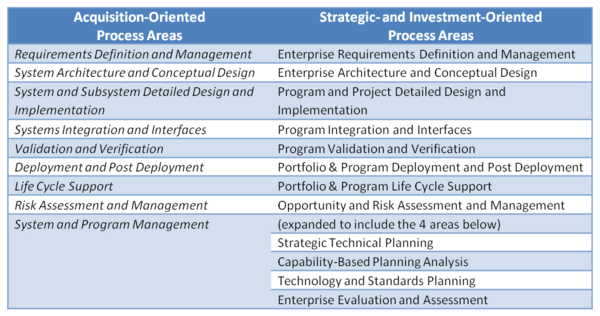An Enterprise Systems Engineering Framework
Martin, J. N. 2010. "An Enterprise Systems Engineering Framework". Paper presented at 20th Anniversary International Council on Systems Engineering (INCOSE) International Symposium, 12-15 July, 2010, Chicago, IL, USA.
Annotation
Traditional systems engineering (SE) is performed on a development project with only one or a few related systems being developed. Enterprise SE, on the other hand, must deal with deciding among many enterprise opportunities that the enterprise projects will work on. This entails several processes that are not provided for in traditional SE practice.
An Enterprise SE Framework (shown below on the right side of the table) was developed to characterize the full scope of SE at the enterprise level. This framework was used to evaluate several case studies as part of doctoral research in the application of SE in large organizations (Martin 2006). This evaluation focused on how they used knowledge modeling techniques identified in the research for development of an enterprise architectures.
Table 1. Extension of TSE to ESE Process Area (Source: (Martin 2010), Used with Permission)
Works Cited
Martin, J. N. 2006. "An enterprise architecture process incorporating knowledge modeling methods". PhD dissertation, George Mason University.
Enterprise Systems Enginereing Key Concepts
Annotation to be added for SEBoK 1.0.
Enterprise Systems Engineering Process Activities
Annotation to be added for SEBoK 1.0.
Related Business Activities
Annotation to be added for SEBoK 1.0.
SEBoK Discussion
Please provide your comments and feedback on the SEBoK below. You will need to log in to DISQUS using an existing account (e.g. Yahoo, Google, Facebook, Twitter, etc.) or create a DISQUS account. Simply type your comment in the text field below and DISQUS will guide you through the login or registration steps. Feedback will be archived and used for future updates to the SEBoK. If you provided a comment that is no longer listed, that comment has been adjudicated. You can view adjudication for comments submitted prior to SEBoK v. 1.0 at SEBoK Review and Adjudication. Later comments are addressed and changes are summarized in the Letter from the Editor and Acknowledgements and Release History.
If you would like to provide edits on this article, recommend new content, or make comments on the SEBoK as a whole, please see the SEBoK Sandbox.
blog comments powered by Disqus